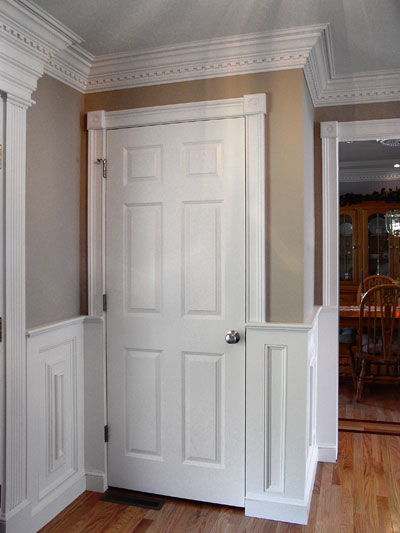The Lost of Art Molding: 3 Things to Avoid
The Lost of Art Molding: 3 Things to Avoid
I gave a lecture a few years ago on classical interiors that I thought was worth reviewing. I used that talk to highlight some current bad habits in millwork and I think it is appropriate to share those now. Here are 3 things to avoid when putting up moldings.
1. Don’t put your wainscot too high:
This is the most often abused and yet easiest mistake to fix when molding a house; DON’T install the chair rail at or above 36″. This is a great misconception shared by some designers and carpenters and if you want to read about this rule, I wrote an article for THISisCarpentry, and you can read it here. I believe the chair rail/wainscot is THE most important molding in a room. This molding does a better job of providing pleasing scale and it is a great room-unifier.

In this example, the wainscot is around 38″ tall and nearly divides the wall in half, ugh! I would lower it 8″-10″, and I typically tell clients and craftsmen to start at 28-32″ in rooms with 8-10′ ceilings.
Unfortunately, this room is not improved by the crown or casing as they are a little over-the-top. ( see rule #2 below). Also, I think the door is ugly (go ahead, ask me how I really feel).
By contrast, I think this wainscot shows the power of the wainscot to unify the interior and improve the scale. The wainscot (painted black on top) unifies the rooms as it intersects and runs through column-pedestals and tops the chair rail or wainscot. The scale is improved because the cap is 28″ tall feels great with 9′ ceilings.
.

.
.
.
.
.
2. Be careful of using too many moldings and too much decoration.
As I work to fix McMansions for various clients around the country, I find the easiest general fix is simply to strip away the excess. Often there are too many materials, competing focal points, and general built-up-molding abuse. The solution? Strip away the excess and simplify.
This is an example of seeking to impress with more. At first glance this room, filled with paneling and moldings, is striking. However, a closer look reveals many flaws. Besides an obvious violation of rule #1, (wainscot too tall) the moldings don’t unify the interior. Note how the pedestal cap and column size on the left are so different from the column and pedestal by the door. They are only 6 feet apart, they should work together instead of competing.

I recently visited with a client whose kitchen has the moldings below. Many crown moldings off the shelf today have way too many bumps and bubbles that make the molding very hard to read. There are a lot of lines in this cornice and it is thus very hard to tell what the moldings actually look like.
.
.
.
.
.
.
.

By contrast, look at this historic moldings at Winterthur on the right. This cornice is simple, bold and direct. It is easy to see what is happening and to read the size and scale. With less moldings and more prominent shapes the moldings actually work better.
.
.

My fix for this excessive built up crown is to SIMPLIFY. The sketch at the left shows how these different approaches play out. Frankly, it was hard for me to even copy the original molding onto paper because I couldn’t read what was happening, even close-up. The fix is fewer moldings that are bolder in their profile. These strong bold shapes are easier to read. They in turn make the kitchen-space more relatable; less confusion, more harmony, a better space.
.
.
.
.

.
.
.
.
.
.
.
.
3. Stop rehashing cheap Victorian moldings:
We need to stop trying to emulate the Victorian era. These moldings in my opinion are just as bad as clam shell moldings. They are cheap copies of an historic style, the don’t help establish scale and are used abused by builders who want to show off their millwork but don’t know how.
This picture highlights a violation of all three rules; wainscot is too high, too many moldings and the Victorian rosette is used unabashedly.

The solution is a lower wainscot, and simpler crown. It’s hard to tell from this picture, but I’m guessing this is a 8′ ceiling with 6’8 doors. It is very hard to put so many moldings in a room with such short ceilings. Less is more; at least it would be in this room.
I don’t want to come across as the molding tyrant but there are rules for building. There are guidelines and building traditions that have been forgotten. We have lost the art of building. Our ignorance shows itself most clearly in how we apply moldings. We can build more beautiful homes, we just need to break some bad habits.
Let me know if you have comments.
-B
__________________________________________________________________________
At Hull Millwork, our singular team of master craftsmen excel in fabrication and installation of architectural elements for commercial, civic, historic, and residential projects. View our gallery of millwork projects or contact us today about your next project.

